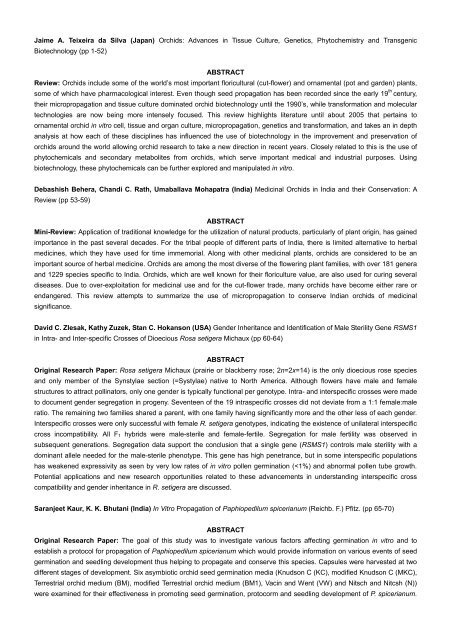Issue infomation - Global Science Books
Issue infomation - Global Science Books
Issue infomation - Global Science Books
You also want an ePaper? Increase the reach of your titles
YUMPU automatically turns print PDFs into web optimized ePapers that Google loves.
Jaime A. Teixeira da Silva (Japan) Orchids: Advances in Tissue Culture, Genetics, Phytochemistry and Transgenic<br />
Biotechnology (pp 1-52)<br />
ABSTRACT<br />
Review: Orchids include some of the world’s most important floricultural (cut-flower) and ornamental (pot and garden) plants,<br />
some of which have pharmacological interest. Even though seed propagation has been recorded since the early 19 th century,<br />
their micropropagation and tissue culture dominated orchid biotechnology until the 1990’s, while transformation and molecular<br />
technologies are now being more intensely focused. This review highlights literature until about 2005 that pertains to<br />
ornamental orchid in vitro cell, tissue and organ culture, micropropagation, genetics and transformation, and takes an in depth<br />
analysis at how each of these disciplines has influenced the use of biotechnology in the improvement and preservation of<br />
orchids around the world allowing orchid research to take a new direction in recent years. Closely related to this is the use of<br />
phytochemicals and secondary metabolites from orchids, which serve important medical and industrial purposes. Using<br />
biotechnology, these phytochemicals can be further explored and manipulated in vitro.<br />
Debashish Behera, Chandi C. Rath, Umaballava Mohapatra (India) Medicinal Orchids in India and their Conservation: A<br />
Review (pp 53-59)<br />
ABSTRACT<br />
Mini-Review: Application of traditional knowledge for the utilization of natural products, particularly of plant origin, has gained<br />
importance in the past several decades. For the tribal people of different parts of India, there is limited alternative to herbal<br />
medicines, which they have used for time immemorial. Along with other medicinal plants, orchids are considered to be an<br />
important source of herbal medicine. Orchids are among the most diverse of the flowering plant families, with over 181 genera<br />
and 1229 species specific to India. Orchids, which are well known for their floriculture value, are also used for curing several<br />
diseases. Due to over-exploitation for medicinal use and for the cut-flower trade, many orchids have become either rare or<br />
endangered. This review attempts to summarize the use of micropropagation to conserve Indian orchids of medicinal<br />
significance.<br />
David C. Zlesak, Kathy Zuzek, Stan C. Hokanson (USA) Gender Inheritance and Identification of Male Sterility Gene RSMS1<br />
in Intra- and Inter-specific Crosses of Dioecious Rosa setigera Michaux (pp 60-64)<br />
ABSTRACT<br />
Original Research Paper: Rosa setigera Michaux (prairie or blackberry rose; 2n=2x=14) is the only dioecious rose species<br />
and only member of the Synstylae section (=Systylae) native to North America. Although flowers have male and female<br />
structures to attract pollinators, only one gender is typically functional per genotype. Intra- and interspecific crosses were made<br />
to document gender segregation in progeny. Seventeen of the 19 intraspecific crosses did not deviate from a 1:1 female:male<br />
ratio. The remaining two families shared a parent, with one family having significantly more and the other less of each gender.<br />
Interspecific crosses were only successful with female R. setigera genotypes, indicating the existence of unilateral interspecific<br />
cross incompatibility. All F 1 hybrids were male-sterile and female-fertile. Segregation for male fertility was observed in<br />
subsequent generations. Segregation data support the conclusion that a single gene (RSMS1) controls male sterility with a<br />
dominant allele needed for the male-sterile phenotype. This gene has high penetrance, but in some interspecific populations<br />
has weakened expressivity as seen by very low rates of in vitro pollen germination (
















